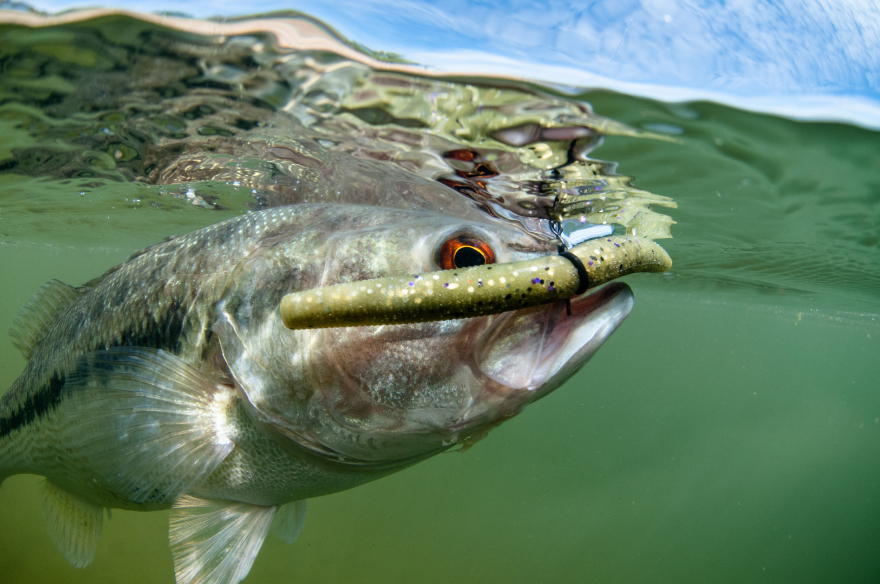Sometimes choosing the right lure color can mean the difference between failure and success when it comes to bass fishing. Every experienced angler has his go-to’s, and in some cases, he may not even know why that lure works so well. He just knows that it does via trial and error, but the truth is, some lure colors really do perform better.
This, of course, depends on more factors than just what the fish prefer. So, you may need to spend some time evaluating your environment before you write off a lure color as a poor performer. Some colors work really well under the right circumstances, but will utterly fail if you use them at the wrong time or place. Light conditions, the depth of the water, weather, and water clarity all play an important role in choosing the best senko colors or worm colors for bass.
Best color plastic worms for bass
Green Pumpkin
This is one of the most asked for lure colors for a reason, it works. Bass love it, and it gets strikes frequently. But what’s so good about it? Well, you may have heard the phrase “match the hatch” being thrown around during your research. This means that you are matching the color of your lure to the forage which bass are currently feeding on.
This green color scheme is common among the natural prey of the Bass. This includes things like various panfish like Bluegill or Sunfish, and even the crawfish, which bares a similar hue on its exoskeleton. You can also pick up several different variations of green pumpkin lures which include metallic flakes or mixes which may perform well depending on the current fishing conditions too.
Green pumpkin with purple or copper flakes is a popular choice for when you need that “flash” to trigger a strike in dirty water. In short, if you’re looking to add one yum dinger worm color to your tackle box, it’s this one.
Junebug
Another fan favorite lure color, Junebug can be a great choice when lighting conditions are not great. While it seems like a brighter color like chartreuse would be the best choice for this situation, that’s not always the case. in fact, June Bug is one of the best lure colors for muddy water.
Because of how bass see things, darker colors like June Bug can provide much needed contrast which helps the fish to see that the bait is something they should eat. This is especially true if you can get a nice sparkle flake color mixed in there.
There are, of course, other variations of this color you can use. Plenty of them have different color flakes you can experiment with, and some even have tails which are a bright yellow or pink color to help add a bit of flash that gets the attention of the fish.
Watermelon Red
While the watermelon red color may look similar to the green pumpkin color, they are different. One of the main features of the watermelon red lure is that it contains shiny little red flakes. These add great flash to your worms, making them irresistible to bass. The watermelon red color works best in clear water conditions though, so if your local water ways are darker it may be a bad pick for you.
This color is also favored by anglers during spawning times in the spring, or in the summer. Bass can see the color red very well, making this lure something that can get their attention if you use it in the correct circumstances.
Baby Bass
A big bass has no problem cannibalizing another fish’s offspring. That means in clear conditions, the “baby bass” color can be quite effective in luring out large bass to have a snack. Wriggling a soft plastic lure of this variety, including worms, or lizards in just the right spot can lure a large mouth into thinking he’s about to make a snack of an injured baby bass.
This color can be particularly great when used in the months following bass spawning season. Why? Well, this is when the big bass will expect to see baby bass ready for dinner. Placing what is expected into the right area can get you more strikes.
Okeechobee Craw
This little color combo gives you the best of two worlds of bass lures. It has that familiar green pumpkin hue, but it also has a striking blue sparkle to it which is sure to grab attention in a variety of water conditions. It mimics a fast moving bluegill’s colors very well, and this often leads to nice strikes from bass waiting in the shadows.
While it’s a more unusual pick, it’s an interesting one that you should definitely consider adding to your tackle box. Pros recommend using this color combo in and around grasses in dingy waters for the best effect.
Okay, so we’ve established that these are the best worm colors for bass, but they are by far not the only colors! While it’s easy to get bogged down in the “rules”, the truth is there aren’t any. If you’re having a slow fishing day then don’t be afraid to throw out a bright pink lure and test it out.
Though it’s also important to be mindful of your water and weather conditions so you can fish smarter. If you need help learning when to use which lure colors where, then you might want to download our free lure color chart guide.
This chart helps you learn which colors work for which situations so you aren’t just tossing anything out and hoping for the best. It covers lure colors for different water clarity levels, light levels, water depths, and forage to help you make the best choice for the day. You can save it to your phone or print it off and keep it in your tackle box.
PS. You might also be interested in our “best chatterbait colors” article.

